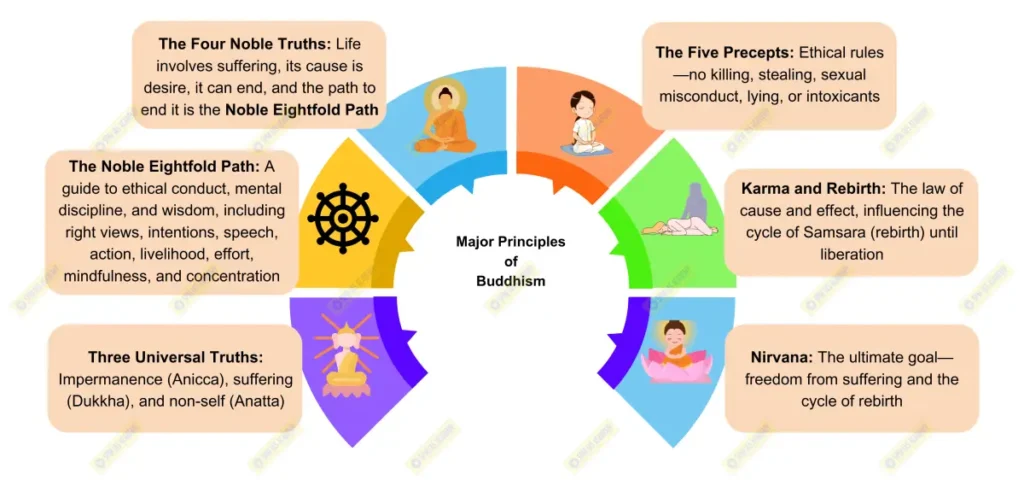Buddhism, with its core principles of interconnectedness, compassion, and mindfulness, offers profound insights into ecological awareness and the conservation of biodiversity. By integrating key Buddhist ideologies with modern environmental challenges, we can explore how the teachings of the Buddha inspire ecological mindfulness to address biodiversity loss.

A. Interconnectedness (Pratityasamutpada) and Ecological Web
- Buddhist Principle: Pratityasamutpada teaches that all beings and systems are interdependent.
- Relevance to Biodiversity: This principle mirrors the ecological web, where species rely on each other for survival. For instance, in North East India, the loss of tree cover in the Eastern Himalayas due to deforestation threatens the hornbill, a key species involved in seed dispersal, thus impacting the entire forest ecosystem.
- Buddhist Insight: Recognizing the interdependence of all life inspires a more holistic view of nature, leading to conservation efforts like forest restoration and species protection, such as the Hornbill Festival in Nagaland, which raises awareness about protecting the species and its habitat.
B. Compassion (Karuna) and Protection of All Life
- Buddhist Principle: Karuna, or compassion, extends to all sentient beings, including animals and plants.
- Relevance to Biodiversity: Human actions such as poaching and habitat destruction cause immense suffering to animals. The Kaziranga National Park in Assam, home to the endangered Indian rhinoceros, faces poaching and habitat encroachment, putting its biodiversity at risk.
- Buddhist Insight: Compassion towards all living beings can drive actions such as anti-poaching laws and conservation efforts like those seen in Kaziranga, where local communities and park officials work together to protect endangered species.
C. Non-Harm (Ahimsa) and Sustainable Practices
- Buddhist Principle: Ahimsa promotes non-violence and discourages harm to any living being.
- Relevance to Biodiversity: Human activities like large-scale mining and deforestation harm ecosystems. For example, illegal coal mining in Meghalaya (rat-hole mining) has caused severe water pollution, affecting aquatic biodiversity in rivers like the Lukha.
- Buddhist Insight: Ahimsa advocates for sustainable practices. Shifting to sustainable livelihoods, like community-based forest management in North East India, where local tribes work to protect sacred groves, ensures the preservation of biodiversity without harming the environment.
D. Mindfulness (Sati) and Ecological Awareness
- Buddhist Principle: Sati, or mindfulness, encourages conscious living, making individuals aware of their actions and their impacts.
- Relevance to Biodiversity: Overconsumption of natural resources leads to habitat destruction and biodiversity loss. The destruction of forests for jhum (shifting) cultivation in Arunachal Pradesh threatens rare species like the red panda and clouded leopard.
- Buddhist Insight: Mindfulness in consumption can reduce the pressure on ecosystems. Practices like sustainable agriculture and agroforestry, promoted in parts of North East India, help reduce deforestation and protect biodiversity by maintaining forest cover while supporting livelihoods.
D. Impermanence (Anicca) and the Fragility of Ecosystems
- Buddhist Principle: Anicca, or impermanence, highlights the transient nature of life and ecosystems.
- Relevance to Biodiversity: Climate change accelerates the impermanence of species and ecosystems. The rapid melting of glaciers in Sikkim and Arunachal Pradesh due to rising temperatures threatens alpine biodiversity, including medicinal plants that are vital to local communities.
- Buddhist Insight: Recognizing impermanence fosters a sense of urgency in conservation. Protecting fragile ecosystems like the Eastern Himalayan alpine region before they vanish aligns with this Buddhist understanding of the transient nature of life, prompting urgent action to preserve biodiversity.
E. Right Livelihood (Samma Ajiva) and Ethical Environmentalism
- Buddhist Principle: Right Livelihood encourages earning a living in ways that do not harm the environment or other beings.
- Relevance to Biodiversity: Destructive industries like coal mining and monoculture farming deplete biodiversity. In Assam, tea plantations have replaced large tracts of forests, reducing habitats for native species like elephants and leopards.
- Buddhist Insight: Practicing Right Livelihood can inspire more ethical professions. Supporting ecotourism in areas like Manas National Park, Assam, promotes wildlife conservation while providing sustainable livelihoods for local communities, protecting biodiversity without causing harm.
Buddhist principles like interconnectedness, compassion, and mindfulness offer a profound ethical foundation for addressing biodiversity loss. These values align with global objectives such as the Sustainable Development Goals (SDGs), promoting sustainable living, climate action, and conservation. As India moves towards the vision of Viksit Bharat, integrating these principles with modern environmental strategies can ensure a future that balances development with ecological sustainability, fostering a harmonious relationship between humans and nature.












